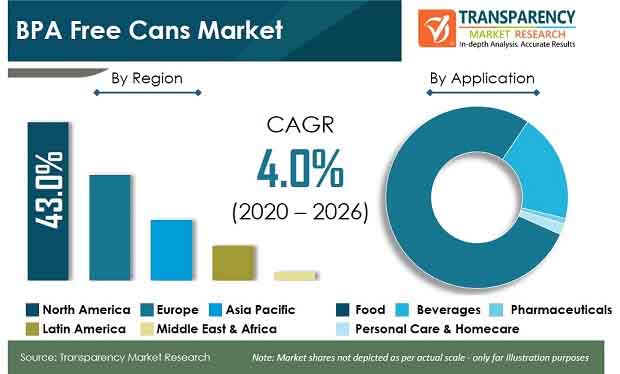Potential Impact of COVID-19 on BPA Free Cans Market
BPA Free Cans Market: Introduction
Transparency Market Research delivers key insights for the BPA free cans market in its published report, which includes global industry analysis, size, share, growth, trends, and forecast for 2020-2026. In terms of revenue, the global BPA free cans market is projected to expand about 1.3x its current market value by the end of 2026, owing to the ever-increasing demand from food industry sub-segments such as fresh fruits & vegetables and ready-to-eat food across several countries about which, TMR offers detailed insights and forecasts in the BPA free cans market report.

BPA free cans are used primarily in end-use industries, including food & beverages, pharmaceuticals, and personal care & cosmetics. BPA free can is a terminology used for metal and plastic cans, internally or externally coated with BPA-free coating solutions such as vinyl, acrylic, polyester, and oleoresins. BPA free cans have gained significant attention in the past few years due to increasing objections of usage of BPA for food packaging applications globally.
For More Details, Request A Sample Report@ https://www.transparencymarketresearch.com/sample/sample.php?flag=S&rep_id=22511
TMR segmented the analysis of BPA free cans market based on various factors such as capacity, product type, material type, and application across five regions. As per the TMR analysis, 2-piece type of BPA free cans are expected to hold the largest market share during the forecast period, as it offers brand owners a modern, stylish way to market their products to end users due to its stackable feature, thus saving shelf space and non-toxic nature.
Growing Consumer Concern over BPA-based Products to Drive BPA Free Cans Market
Concerns over the use of BPA-based products have increased significantly in the past few years. Several organizations have invested hefty amounts in the research activities to find out health hazards of BPA-based products. Moreover, they are continuously engaged in creating public awareness to give up on BPA containing products such as metal cans. However, government in most countries still do not find BPA harmful and hence, have not banned the use of BPA in food contact applications. However, the decline in the use of BPA-based products in most of the developed countries is primarily driven by consumer disinterest but not by government enactments. Moreover, consumer disinterest in BPA-based products led food processing companies to switch their packaging products or use BPA free coatings in their metal can packaging format, which has ultimately increased the demand for BPA free cans.

